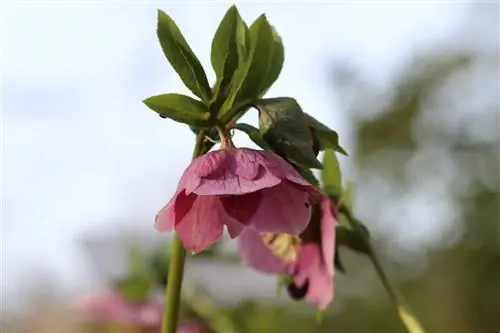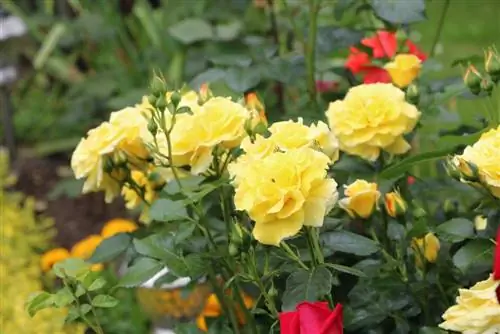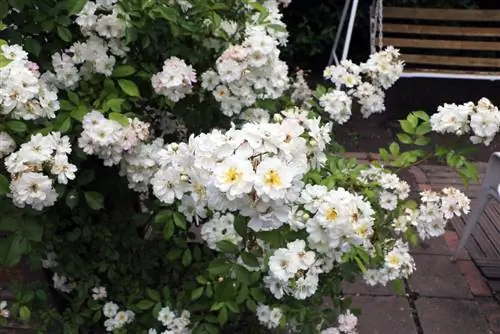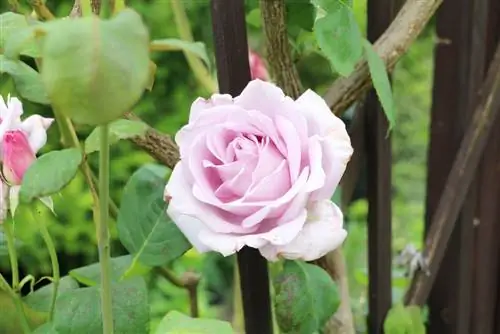- Author admin [email protected].
- Public 2023-12-17 03:39.
- Last modified 2025-06-01 06:48.
If you want to enjoy the magnificent flowers of the Lenten rose in winter, you have to care for them professionally. Choosing the right location and substrate as well as carrying out certain care measures are crucial.
Location
The Lenten rose is relatively adaptable to the location, as it can be cultivated in both sunny and shady places. Full sun is only tolerable for the spring rose if there is sufficient soil moisture. In the shade, however, limited growth can be expected. However, the spring rose feels most comfortable in partial shade, such as under larger deciduous trees and bushes. In addition, the following must be taken into account with regard to the location:
- Plants per square meter: 6 - 7
- Planting distance approx. 40 cm
- Spring rose grows very wide
- Avoid direct proximity to conifers, ericaceous plants and rhododendrons
Tip:
Lenrzos can be cultivated in open spaces as well as in perennial beds or on the edge of trees.
Soil / Substrate
In order for the spring rose to grow and thrive magnificently, the soil should meet certain requirements. A humus-rich loamy soil that is fresh and permeable is best. If these conditions are not met, the soil can be improved accordingly. Depending on the floor, a mixture of different materials is suitable for this:
- Sandy soil: Compost, clay and a handful of horn shavings
- Compacted soil: Sand, fine grit, compost and bark humus
- Acid soil: Lime fertilization
Pots / Buckets
The Lenten rose is less suitable as a houseplant, but it can certainly be cultivated in a pot and placed outdoors. However, it is important to take into account that despite their slow growth, the plants require a lot of space over time. For this reason, it is worth rejuvenating the plant every two to three years. In addition, the following must be taken into account when cultivating in the bucket:
- Thick-walled vessel offers protection from frost
- Additional frost protection recommended
- Wrap the tub with bubble wrap or garden fleece
- Substrate: Potting soil or potting soil with a low peat content
Wintering
The Lenten rose is hardy and can easily survive temperatures of up to -28 degrees Celsius. For this reason, it generally does not need any winter protection. However, it still makes sense to cover the perennial with a layer of mulch, as this will help it sprout better. For young plants, however, frost protection is recommended, otherwise dense blankets of snow can be their downfall.
Propagation
The spring rose can be propagated in two ways: firstly by sowing and secondly by division.
Division
Division is generally more recommended because it is quick and promising. For smaller specimens, the rhizome is simply divided carefully with a knife. Dividing larger spring roses is a little more complicated:
- Tie stems and leaves together with a ribbon
- The risk of injury is therefore lower
- Pick off as large a root ball as possible
- Put two pitchforks through the middle of the root ball
- Rhizome is thereby torn open
To prevent the roots from drying out, the sections should be planted immediately. It is also advisable to water thoroughly afterwards so that the rootstock is moistened to a depth of around 10 to 15 centimeters.
Sowing
Sowing spring roses is certainly possible, but requires a lot of patience. After all, it can take around three to five years until the first flowering occurs. If you still want to try sowing, all you need is the seeds, some potting soil and suitable planters. The sowing itself takes place in two phases:
- Fill planters with substrate
- Place seeds in soil and press lightly
- Do not cover seeds with soil
- Cover the vessel with transparent film
- Place in a partially shaded place
- About 6 weeks at around 22 - 24 degrees Celsius
- Keep the substrate moist during this time
After the first phase, it is important that the seedlings are exposed to a cold stimulus. For this reason, they should then be cared for for around four weeks at around -4 to +4 degrees Celsius. The temperature can then be increased gradually, although it should not rise above 10 degrees until the end. As soon as the young plants have at least two pairs of leaves, they can be pricked out and hardened off before they take up their permanent place outdoors.
Planting
The Lentenrose is best planted in spring after flowering. For freshly planted specimens, it is advisable to remove all flower stems. Because of this care measure, the plants root faster and grow stronger the following year. When planting, you should also make sure that the planting hole is approximately twice as large as the root ball. To ensure that the plants get off to a good start, the soil should be loosened well and covered with a layer of mulch.
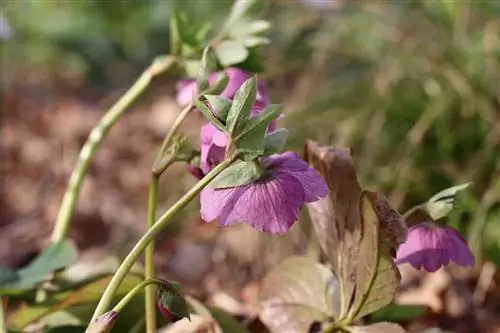
Fertilize
Lenrzoses are weak feeders, which is why they only need a little fertilization. Liquid fertilizer should therefore be avoided if possible. Instead, it is advisable to use slow-release fertilizers that release their nutrients slowly and over a longer period of time. For spring roses, it is recommended, among other things, to improve the soil with compost. In addition, adding a layer of mulch is worthwhile for the following reasons:
- Soil stays sufficiently moist
- Weeds are kept away
- Rotting material releases nutrients
Tip:
A suitable mulch layer includes brushwood, bark mulch or withered leaves.
Pouring
When it comes to watering the spring rose, it's better to be dry than moist! Especially in summer, the plant proves that it can cope well with dry hay even temporarily. However, dry periods that are too long are not recommended, as this has a negative effect on the flowering. For this reason, it is advisable to keep the spring rose substrate evenly moist. Additionally, the following must be taken into account when pouring:
- Avoid waterlogging
- Watering as soon as the top layer of soil has dried
- Testing using a finger test
Note:
Particularly in the first half of the year during growth, pay attention to regular and even watering!
Repotting / Transplanting
Transplanting the Lenten rose is generally less recommended because it forms a very strong rootstock. As it gets older, this extends deeper into the soil and can easily be damaged when transplanting. Injuries to the roots are associated with impaired growth in the new location, which is why the Lenten rose should preferably remain in its original place.
Cutting
Regular cutting of the Lenten rose is not necessary, but it can be cut back in autumn or before flowering if necessary. Regular care measures, however, include removing wilted or diseased leaves. When working on the plant, however, it is important to remember that there is a very high level of poison in the plant sap. For this reason, you should always pay attention to the following when cutting:
- Be sure to wear gloves!
- Do not dispose of clippings in compost
- Keep pets away from plants
Pests and diseases
The spring rose is relatively insensitive to plant diseases, as only black spot disease occurs more frequently. It is also not often attacked by pests - with the exception of aphids. However, these can simply be rinsed off with a jet of water. If there is a severe infestation, it is also worth treating with a detergent solution.

